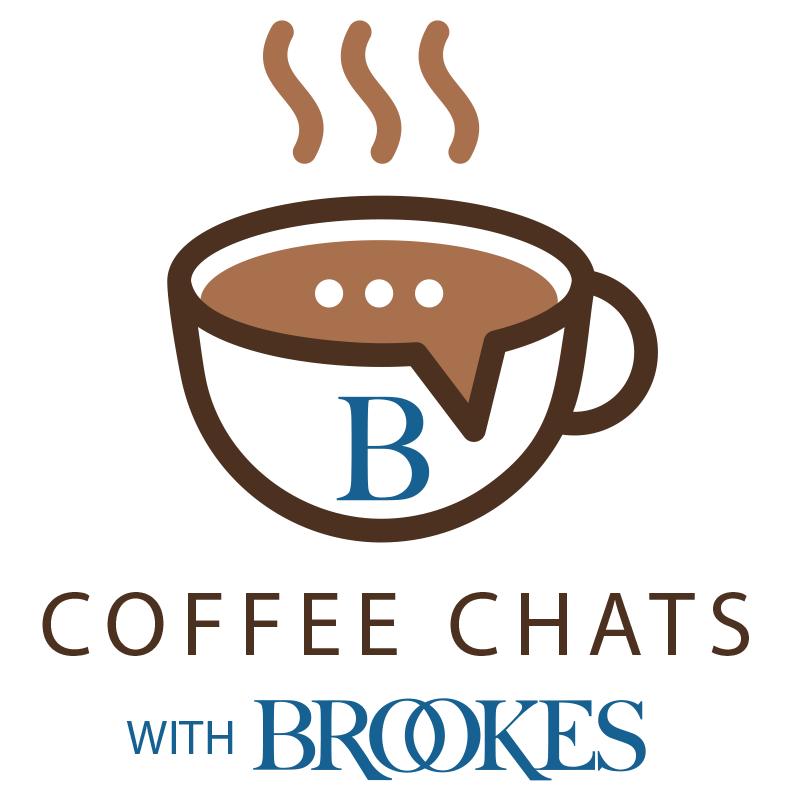
13 minute read
Literacy
NEW
BESTSELLER!
Comprehensive Literacy for All
By Karen A. Erickson, Ph.D., & David A. Koppenhaver, Ph.D.
Literacy improves lives—and with the right instruction and supports, all students can learn to read and write. That’s the core belief behind this teacher-friendly handbook, your guide to providing high-quality literacy instruction to students with significant disabilities. Drawing on decades of classroom experience, the authors present their own innovative model for teaching students with a wide range of significant disabilities to read and write print in grades preK–12 and beyond.
READERS WILL: • Discover 10 success factors for helping students with significant disabilities become literate • Teach emergent readers and writers skillfully, with strategies for shared and independent reading, early writing instruction, and alphabetic and phonological awareness • Help students acquire conventional literacy skills, with strategies for teaching reading comprehension, vocabulary, writing, decoding, and spelling • Use assistive technology effectively • Engage and motivate students and make literacy instruction meaningful to their everyday lives
PRACTICAL MATERIALS: Sample teaching scenarios and dialogues, how-to strategies, and downloadable resources, including sample lessons, lesson sequences, and flowcharts to guide instruction.
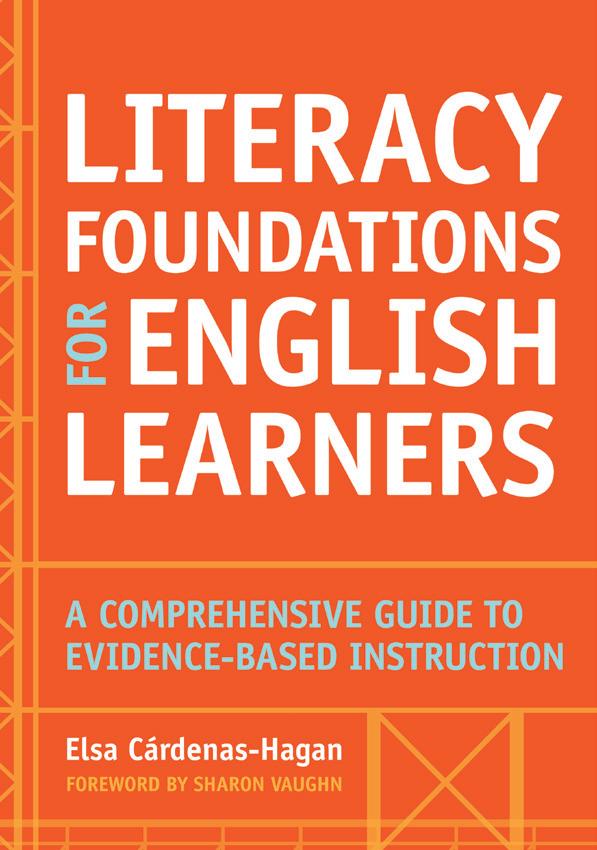
With online faculty materials!
Literacy Foundations for English Learners A Comprehensive Guide to Evidence-Based Instruction
Edited by Elsa Cárdenas-Hagan, Ed.D., CCC-SLP, CDT, CALT, QI
Millions of English learners attend U.S. public schools— and yet only a small fraction of education professionals are certified to work with them. Fill that gap in education with this comprehensive text, an evidence-based guide to providing English learners in Pre-K–Grade 6 with explicit, systematic instruction on the key components of language and literacy. For each component, you’ll get a dedicated chapter with research-based insights on how to teach English learners, guidance on making connections across languages when teaching that component, and ready-to-use principles and strategies for instruction. Learning objectives, study questions, and extended application activities help you grow your knowledge and apply it in classrooms.
GET READY TO
Teach English learners key components of language and literacy: phonological awareness, phonics, vocabulary, fluency, comprehension, spelling, and writing skills Apply insights from the science of reading on how best to teach English learners Use specific, evidence-based principles, strategies, activities, and sample dialogues to guide and strengthen your instruction Leverage technology to adapt and enhance instruction for English learners
$44.95 | Stock #: 20202-79659 | 2020 | 264 pages | 7 x 10 | paperback | ISBN 978-1-59857-965-9
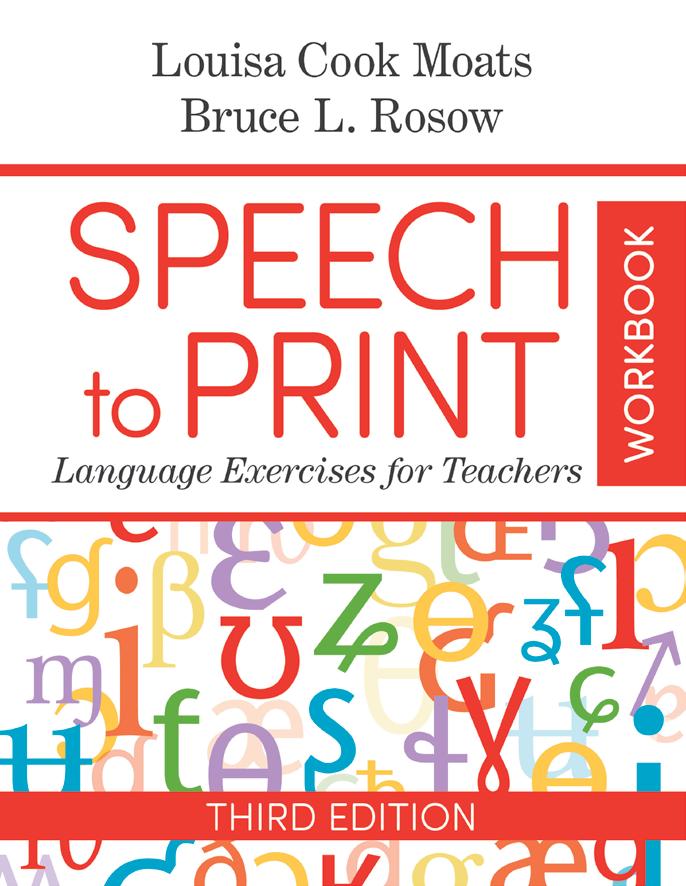

BESTSELLER!
WATCH AN EDWEB WEBINAR WITH LOUISA MOATS! https://bit.ly/LM-Webinar Speech to Print: Language Essentials for Teaching Reading
Book—$44.95 | Stock #: 20202-53305 2020 | 344 pages | 7 x 10 | paperback | ISBN 978-1-68125-330-5
Workbook—$32.95 | Stock #: 20202-53336 2020 | 264 pages | 8 ½ x 11 | paperback | ISBN 978-1-68125-333-6
NEW edition of core literacy text!
SEE PAGE 43 to learn more! Speech to Print Language Essentials for Teachers, NEW Third Edition BOOK by Louisa Cook Moats, Ed.D. WORKBOOK by Louisa Cook Moats, Ed.D., & Bruce L. Rosow, Ed.D.
For two decades, the Speech to Print book and workbook have been bestselling resources on explicit, high-quality literacy instruction. Now the anticipated third editions are here, fully updated for today’s K-12 educators.
THE BOOK Filling a critical gap in teacher preparation courses, Speech to Print supplies educators with in-depth knowledge of the structure and function of language— fundamentals they need to deliver successful structured literacy instruction. Renowned literacy expert Louisa Cook Moats gives current and future teachers comprehensive, accurate, and accessible information on the underpinnings of language instruction, plus case studies, activities, recommended teaching principles, and close analysis of real-world student work samples.
WHAT’S NEW:
New and expanded practical content on the how of instruction New and updated chapter exercises New faculty support materials, including chapter quizzes, a sample syllabus/course outline, PowerPoints, and PDF handouts for selected concepts More on key topics like program and curricula selection, frameworks for instructional planning, and problem solving when students are slow to respond to intervention More accessible, undergraduate-friendly tone and structure Additional graphics to illustrate key concepts
THE WORKBOOK The ideal companion to the third edition of the bestselling Speech to Print text, this workbook helps teachers deepen their understanding of spoken and written English, practice and strengthen their skills and knowledge, and prepare to deliver high-quality reading instruction. WHAT’S NEW: More than 30 new exercises not found in the Speech to Print textbook • Revised and updated exercises throughout • Extensive new content and exercises addressing syntax and semantics • New chapter quizzes • Exercises that provide models and tips for teaching select concepts to students • A new final course exam
Discover how to use evidence-based instruction to increase the reading and writing achievement of Pre-K-6 students, including those at risk for reading difficulties. Fully revised and updated, the new edition of this core text covers the research base for structured literacy instruction and practical guidance on the essential components of literacy instruction.
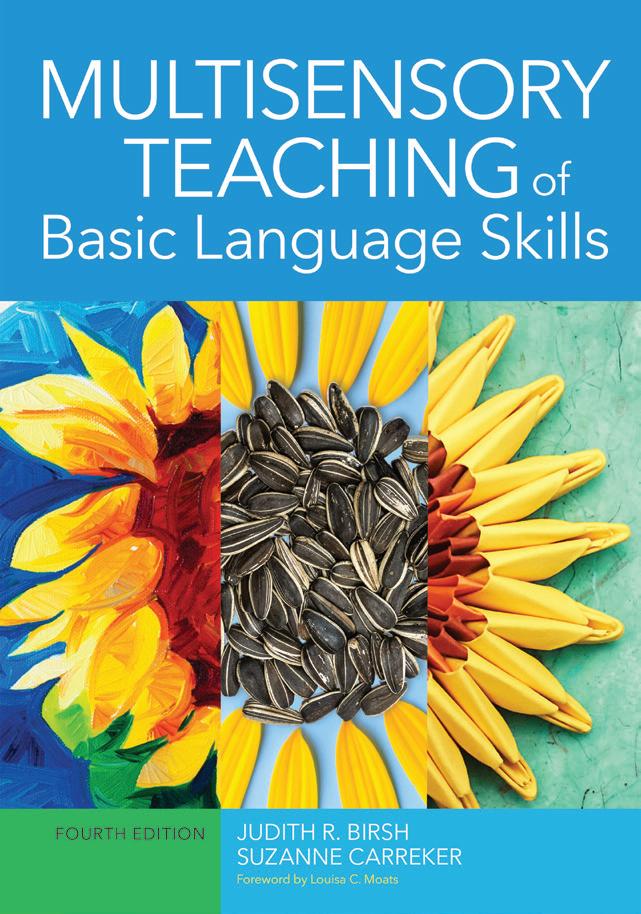
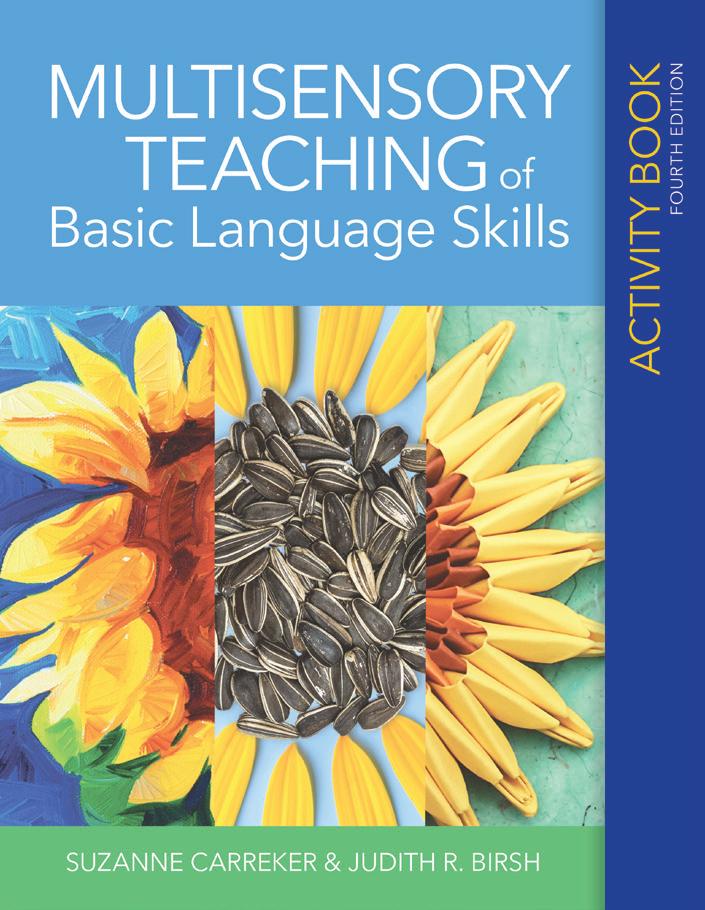
NEW
BESTSELLER!
Multisensory Teaching of Basic Language Skills Fourth Edition
BOOK edited by Judith R. Birsh, Ed.D., CALT-QI, & Suzanne Carreker, Ph.D., CALT-QI ACTIVITY BOOK by Suzanne Carreker, Ph.D., CALT-QI, & Judith R. Birsh, Ed.D., CALT-QI
Keep up with the latest on the highly respected multisensory teaching approach to literacy with the new fourth editions of this bestselling textbook and activity book!
IN THE TEXTBOOK, educators will get timely new information on using multisensory literacy approaches effectively with K–12 students who have dyslexia and other learning disabilities. Updates include:
New chapters on prekindergarten literacy, executive function, and math learning disabilities Content aligned with the 2018 IDA Knowledge and Practice Standards for Teachers of Reading; prepares students for the IDA certification exam The latest research in the field New insights and guidance on technology Online companion materials and resources Learning objectives, reflection questions, and new case studies
IN THE ACTIVITY BOOK, educators will get more than 100 activities that boost their knowledge in all the areas covered in the textbook. The updated edition includes NEW activities on executive function, prekindergarten literacy, and math learning disabilities.
Book—$84.95 | Stock #: 20202-52261 | 2019 | 920 pages | 7 x 10 | hardcover | ISBN 978-1-68125-226-1
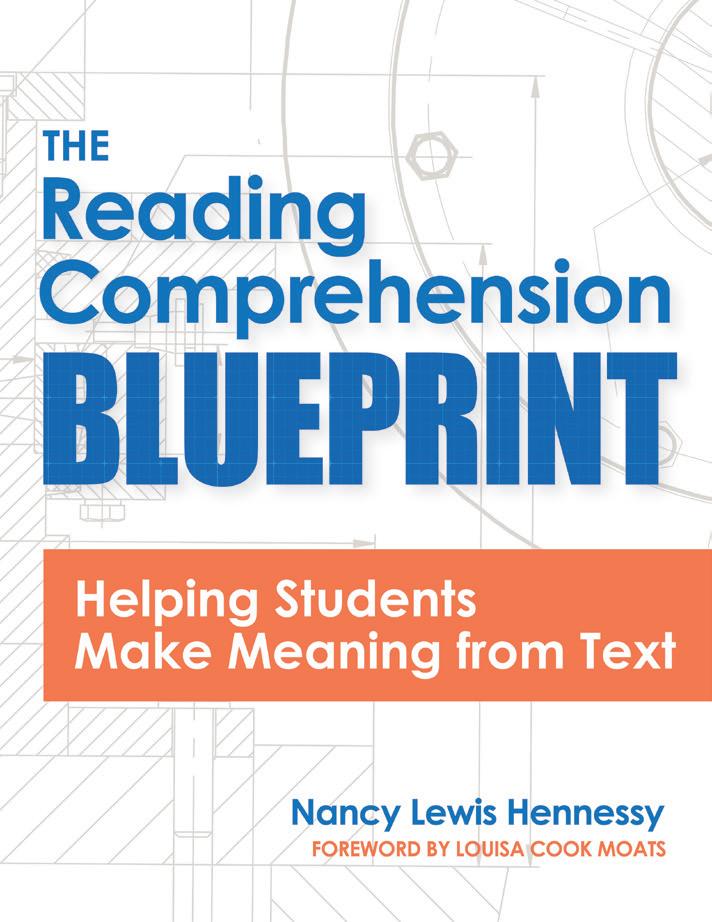
The Reading Comprehension Blueprint
Helping Students Make Meaning from Text
By Nancy Lewis Hennessy, M.Ed.
Comprehension is a primary ingredient of reading success— but most educators aren’t taught how to deliver structured comprehension instruction in their classrooms. K–8 teachers will find the guidance they need in this groundbreaking professional resource from Nancy Hennessy, former IDA President and an expert on reading comprehension. Aligned with the science of reading and IDA’s Structured Literacy approach, this book offers a clear blueprint for understanding the complexities of reading comprehension and delivering evidence-based instruction that helps students construct meaning from challenging texts.
EDUCATORS WILL: • Get critical background knowledge that synthesizes decades of research on reading comprehension • Master the blueprint, which is a complete framework for organizing instruction on each facet of reading comprehension, including vocabulary, syntax and sentence comprehension, text structures, background knowledge, and levels of understanding and inference • Make it work in the classroom, with practical guidance and tools for planning their lessons, adapting to the needs of individual students, and assessing progress
PRACTICAL MATERIALS: Teachers will get classroom activities, sample lesson plans, questions that help them reflect on and strengthen their practices, and photocopiable teaching resources (including unit and lesson plan organizers).
TPRI ® and Tejas LEE ® are two comprehensive systems for helping English- and Spanish-speaking students make real reading progress in K–3. Guiding teachers step-bystep through diagnostic assessment, targeted intervention, and effective progress monitoring, these two authentic, research-based systems solve key challenges for everyone— teachers, students, and whole schools.
Learn more at bit.ly/TPRITejas
TPRI ® Benchmarking Kit (Teacher’s Guide, Story Booklet, Task Cards, & Stopwatch) | $189.95 | Stock #: 20202-71257 | 2010 Tejas LEE ® Assessment Kit (Teacher’s Guide, Story Booklet, Task Cards, and Stopwatch) | $189.95 | Stock #: 20202-71417 | 2011 See more TPRI and Tejas LEE ® products at www.brookespublishing.com
The first teacher training text to cover all four learning disabilities that require differentiated instruction, this accessible text prepares you to deliver explicit, engaging instruction customized to K–12 students’ needs. You’ll uncover both the why and the how of differentiated instruction, use it effectively to organize routines and lesson plans, and learn from clear explanations of current research findings.
By Virginia W. Berninger, Ph.D., & Beverly J. Wolf, M.Ed.
$46.95 | Stock #: 20202-78942 | 2016 | 320 pages | 7 x 10 | paperback | ISBN 978-1-59857-894-2
Vocabulary knowledge plays a huge role in the academic success of middle school students. But which words do students need to know to master the content in their textbooks, and how can they be learned? This book has practical answers. You’ll get five extensive, research-based lists of vocabulary words frequently used in textbooks, plus guidance and activities to help you weave vocabulary instruction into everyday lessons.
By Jennifer Wells Greene, Ph.D., & Averil Coxhead, Ph.D. Packed with invaluable materials for instruction in pre-K through middle school, this bestselling text expertly prepares you to teach decoding and spelling skills by teaching students the origins of words and helping them understand and correctly use components of the English language. PractiBESTSELLER! cal materials include classroom activities, lesson plans incorporating multisensory language-based instruction, samples of student work, clear explanations of research, and more. An essential text for college courses on reading instruction and an ideal professional development resource for inservice educators!
By Marcia K. Henry, Ph.D.
$42.95 | Stock #: 20202-70748 | 2010 | 352 pages | 7 x 10 | paperback | ISBN 978-1-59857-074-8
Understand key research on vocabulary instruction and put best practices to work with this book. You’ll get in-depth, ready-to-use guidance on the three main elements of high quality vocabulary instruction: specific word instruction, independent word-learning strategies, BESTSELLER! and word consciousness. Includes detailed sample lessons with stepby-step instructions and explicit scripts! (Revised and updated reprint includes appendices now available for download online.)
By Linda Diamond & Linda Gutlohn
$34.95 | Stock #: 20202-69285 | 2006 | 232 pages | 8 x 11 | layflat paperback | ISBN 978-1-55766-928-5
In this one-of-a-kind text, discover why RTI is today’s best approach for preventing reading difficulties—and how research on reading profiles can enhance the power of RTI for struggling readers in Grades K–6. Explore how to identify and address specific types of reading difficulties, understand reading problems in relation to poor reader profiles, and make research-based decisions.
By Louise Spear-Swerling, Ph.D.
$44.95 | Stock #: 20202-73152 | 2015 | 256 pages | 7 x 10 | paperback | ISBN 978-1-59857-315-2
Effective Literacy Instruction for Learners with Complex Support Needs Second Edition
By Susan R. Copeland, Ph.D., BCBA-D, & Elizabeth B. Keefe, Ph.D.
What are today’s best methods for teaching literacy skills to K–12 students with complex support needs? This comprehensive guidebook has up-to-date, evidence-based answers. You’ll discover current recommended practices on critical topics, plus powerful lesson planning strategies, practical examples, and case studies.
SELECTED TOPICS COVERED: phonics instruction • vocabulary • fluency • writing instruction • UDL • instruction for English language learners • standards-based IEPs • differentiated instruction • music and drama in literacy learning • literacy in postsecondary education and employment settings
$49.95 | Stock #: 20202-50595 | 2018 | 400 pages | 8 ½ x 11 | paperback | ISBN 978-1-68125-059-5
“If you have to choose one resource on written expression, this is it! “ —Sheldon Horowitz, Director of
Professional Services, National
Center for Learning Disabilities
By Karen R. Harris, Ed.D., Steve Graham, Ed.D., Linda Mason, Ph.D., & Barbara Friedlander, M.A., NBCT
$44.95 | Stock #: 20202-67052 | 2008 | 444 pages | 8 ½ x 11 | paperback | ISBN 978-1-55766-705-2
“An outstanding book that every reading teacher should have . . . written in an approachable manner and chock full of practical tips.” —Robert Reid, University of
Nebraska
By Carolyn A. Denton, Ph.D., Sharon Vaughn, Ph.D., Jade Wexler, Ph.D., Deanna Bryan, & Deborah Reed, Ph.D.
$49.95 | Stock #: 20202-72438 | 2012 | 328 pages | 8 ½ x 11 | layflat paperback | ISBN 978-1-59857-243-8
BESTSELLER!

Teaching Reading Sourcebook Third Edition
By Bill Honig, Linda Diamond, & Linda Gutlohn
“Provides both distilled theory and research, with lessons you can teach tomorrow morning.“—Shane Templeton, Ph.D., University of Nevada, Reno
A bestselling, research-based guide to effective reading instruction, the Teaching Reading Sourcebook helps current and future educators bridge the gap between evidence-based reading research and actionable instruction strategies. Organized according to the guiding questions behind explicit instruction (what?, why?, when?, and how?), this third edition includes both a research-informed knowledge base and practical sample lesson models to use in the classroom. Teachers will learn about five key elements of an effective reading program—phonemic awareness, decoding, vocabulary development, fluency, and comprehension—and they’ll get teaching tips and intervention strategies to help them put principles into practice.
WHAT’S NEW: A new chapter on MTSS and its 4 key components of implementation • Revised assessment table aligned to MTSS chapter • Updated research references throughout • Common profiles of reading difficulties • Updated NAEP results • New statistics about English language learners • Newest Hasbrouck and Tindal Oral Reading Fluency Norms
INCLUDES ONLINE INSTRUCTOR RESOURCES: Quizzes, slides, learning objectives, and more.
$85.00 | Stock #: 20202-22354 | 2018 | 848 pages | 8 ½ x 11 | paperback | ISBN 978-1-63402-235-4
THE EXTRAORDINARY BRAIN SERIES
Groundbreaking research on dyslexia and language
All About Language Science, Theory, and Practice
NEW
Edited by Elena Grigorenko, Ph.D., Yury Shtyrov, Ph.D., & Peggy McCardle, Ph.D., M.P.H.
EXPLORES THE QUESTION: What do we know today about the development of human language, and what future research will help improve diagnosis of disorders and ensure effective intervention?
COVERS TOPICS SUCH AS: how infants learn and build a body of words, whether language impairments are inherited, how students with reading difficulties respond to intervention, what role executive function plays in both reading development and disorders, what recent studies say about the relationship between spoken and written language, and more.
$79.95 | Stock #: 20202-53558 | 2020 | 280 pages | 6 x 9 | hardcover | ISBN 978-1-68125-355-8
Advances in Reading Intervention Research to Practice to Research
Edited by Carol McDonald Connor, Ph.D., & Peggy McCardle, Ph.D., MPH
EXPLORES THE QUESTION: What do we know—and what do we need to know—about effective reading and writing intervention?
COVERS TOPICS SUCH AS: neurobiological bases of word recognition and comprehension, writing challenges of children with dyslexia, reading development and difficulties among English learners, how behavioral genetics can inform education, how to apply research to the classroom.
$39.95 | Stock #: 20202-79680 | 2015 | 312 pages | 7 x 10 | paperback | ISBN 978-1-59857-968-0 Dyslexia Revisiting NEW Etiology, Diagnosis, Treatment, and Policy
Edited by Julie A. Washington, Ph.D., Donald L. Compton, Ph.D., & Peggy McCardle, Ph.D., M.P.H.
EXPLORES THE QUESTION: How do children develop reading skills—and when these skills don’t develop typically, how can we best identify challenges and intervene?
COVERS TOPICS SUCH AS: early identification of children at risk for reading difficulty, use of neuroimaging and molecular genetics to better understand the origins of dyslexia, the impact of race, poverty, and linguistic differences on diagnosis, the current state of teacher preparation programs, how to scale up evidence-based interventions for reading disorders, and more.
$79.95 | Stock #: 20202-53619 | 2020 | 320 pages | 6 x 9 | hardcover | ISBN 978-1-68125-361-9
Dyslexia and Neuroscience The GeschwindGalaburda Hypothesis 30 Years Later
Edited by Albert Galaburda, M.D., Nadine Gaab, Ph.D., Fumiko Hoeft, MD, Ph.D., & Peggy McCardle, Ph.D., M.P.H.
EXPLORES THE QUESTION: What have we learned in the three decades since the Geschwind-Galaburda hypothesis defined the field of dyslexia, and what still needs to be investigated?
COVERS TOPICS SUCH AS: clinical and sociological aspects of dyslexia, reading in children with developmental disorders, sex differences in cognition and learning, animal models of early neural disruption, the genetics of reading disability.









